Superspreader for PoE Lighting
Superspreader for PoE Lighting
Powering light through the data IP network using Category cable, instead of hazardous 120V electrical systems is creating a superspreader of PoE technology throughout all buildings and outdoor applications. With the emergence of smart/intelligent buildings, PoE lighting is on forefront of driving converged building application advancements. LEDs are inherently DC, so installation is greatly simplified by eliminating separate power and control wiring. And because LEDs require little energy and are powered through Ethernet cables, they easily create a connected system providing many benefits over traditional independent ballast/lamp systems, but can also present new challenges when it comes to the design of the cabling topology.
Many IT players are designing and installing LED PoE-powered lighting systems as part of the intelligent building infrastructure to reap numerous benefits. From commercial office and data center employees to retail shoppers, from hotel guests to patients at a hospital, building occupants are demanding a more customized, comfortable, and smart building experience. Smart and connected LED-based lighting is a key part of the picture with associated control systems which account for HVAC systems, air quality, and more. Building owners and managers are realizing that the implementation of a PoE lighting system allows numerous energy efficient and sustainability benefits such as: installation savings through low-voltage cabling (vs. electrical products and installation); LED averages 70% more efficient cost savings than fluorescent or HID lamps; UL924 compliancy which eliminates a separate emergency lighting network; and can be monitored and scheduled through an integrated management system which also optimizes work space. In addition, without line-voltage connections, light fixtures and sensors can be more easily added, reconfigured and upgraded.
PoE lighting is gaining ground and providing growth opportunities for all IT designers and integrators. According to a report by Fortune Business Insights, the global PoE LED lighting market will rise from a value of 192.3 million units in 2018 to 544.8 million units by the end of 2026. The forecast period is set from 2019 to 2026 and the market for PoE LED lighting is anticipated to rise at a compound annual growth rate (CAGR) of 14.1%.
PoE Safety Ratings
With the ratification of IEEE P802.3bt which recognizes 60W (Type 3) and 90W (Type 4) of power (PoE) to run over twisted pair cabling, there is growing concern of excessive heat generation due to additional current (amperage) running through the cable. Bundled cable is especially vulnerable to heat build-up. As a result, UL created a certification called “LP” (Limited Power) which includes a test procedure for determining how many amps a conductor can safely accommodate. Some cable manufacturers have submitted their twisted-pair cables to be tested and earn that rating.
An alternative to LP cables is to refer to the ampacity chart, which was published by the National Electrical Code® (NEC) in Section 725 of the 2017 NFPA 70®. This chart is based on allowable amps for each conductor’s current carrying capacity at 60W or above, and is determined by the cable’s mechanical (operating) temperature, gauge size (AWG) of the conductors and bundle size. This table is solely based on an ambient temperature of 30° C (86° F). As expressed in the chart, the larger the AWG, the better performing the cable and the greater the bundles for higher wattage. Note that a 4-pair cable constructed with 22 AWG conductors, such as the GameChanger Cable™ from Paige Datacom would be recommended as the best choice to safely transmit over 60W and with a maximum bundle size of 192 cables without having to carry the LP rating .
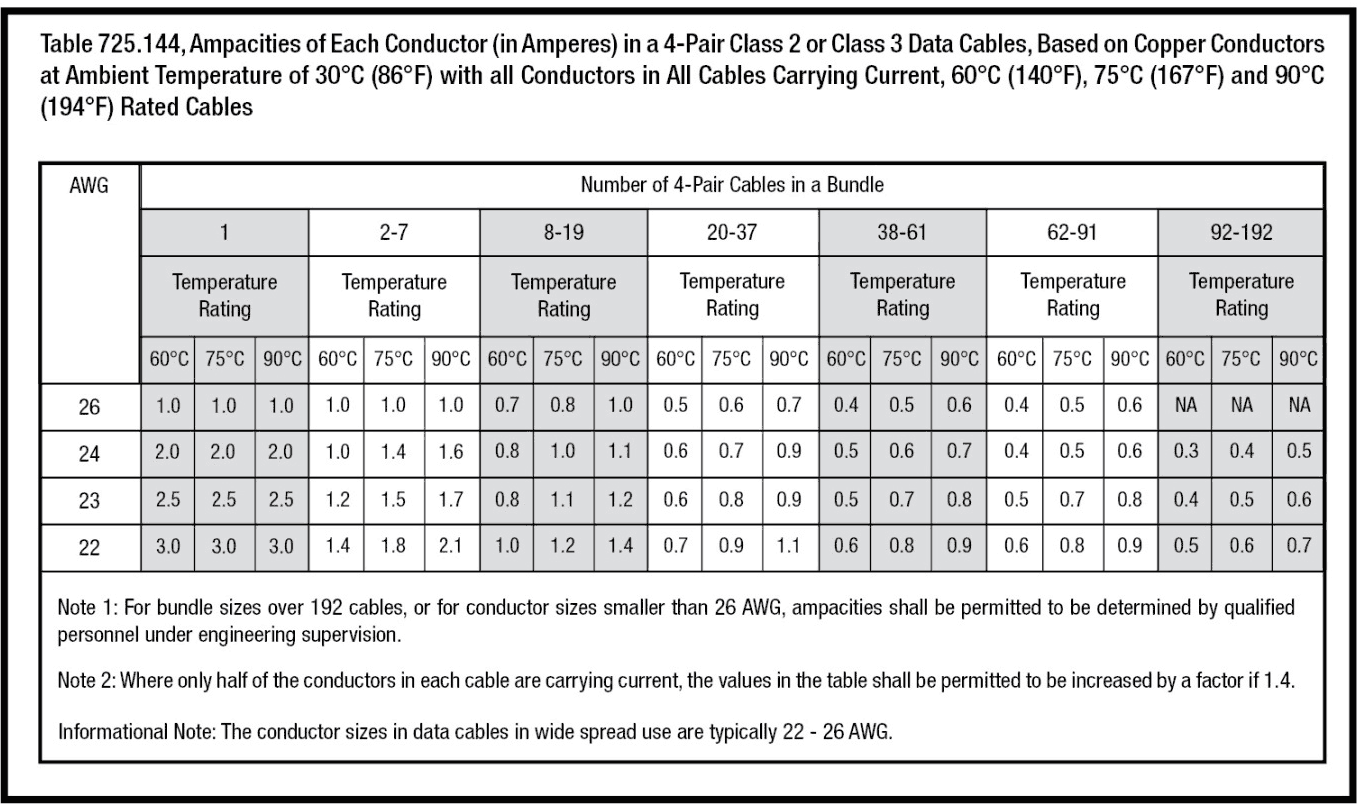
System Architecture
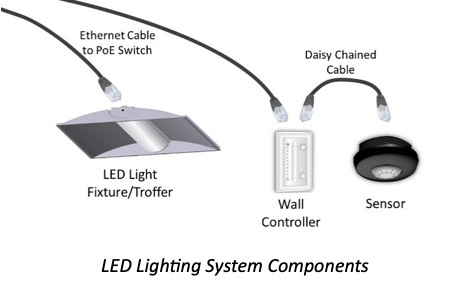 There are different architecture designs for PoE LED lighting. PoE lighting systems contain multiple components connected through Ethernet cabling: the PoE switch — the power supply for the PoE lighting systems — provides the needed voltage for the lighting system ; LED luminaires (such as troffers); wall controllers and ceiling sensors. The wall controllers are wall switches and are usually directly connected to the sensors which sense occupancy, daylight harvesting or ambient temperature.
There are different architecture designs for PoE LED lighting. PoE lighting systems contain multiple components connected through Ethernet cabling: the PoE switch — the power supply for the PoE lighting systems — provides the needed voltage for the lighting system ; LED luminaires (such as troffers); wall controllers and ceiling sensors. The wall controllers are wall switches and are usually directly connected to the sensors which sense occupancy, daylight harvesting or ambient temperature.
There are two industry standards that provide well-defined guidelines for the design, planning and installation of PoE LED lighting systems as an integral part of an intelligent building infrastructure — TIA-862-B-2016 Structured Cabling Infrastructure Standard for Intelligent Building Systems and ANSI/BICSI-007-2020 standard, Information Communication Technology Design and Implementation Practices for Intelligent Buildings and Premises. These two documents complement each other in the IP cable installation planning of intelligent building applications. Specific content in the TIA standard provides guidelines for cabling types, topology, design and installation best practices and test procedures for any size building or premise. The BICSI standard leverages the TIA requirements but gets more granular with best practices for planning spaces, topology and media selection for the specific building applications, including a detailed chapter on LED lighting. In addition, the BICSI standard recognizes that in many instances, the cabling infrastructure and cabling selection of the horizontal cabling may vary as it should be planned to incorporate the deployment of numerous building systems that may utilize an IP network. In addition, BICSI-007 recognizes that some building systems may require cabling other than balanced twisted-pair or optical fiber because of system and application architecture or manufacturer requirements. In fact, primary decisions for cabling type are often based on manufacturer requirements, signal type, distance and location, power requirement, and longevity of building occupancy.
Depending on the cabling requirements of the lighting manufacturer, the horizontal cable can run in a star topology from the telecommunications room (TR) directly to the lighting (also known as point-to-point). However, some lighting manufacturers incorporate a node (or a gateway device) where the Ethernet cable runs from the switch (either an endspan in the TR or a midspan within the horizontal run or housed in a zone enclosure) to the node to maximize the usage of each port. (For more information on zone cabling design, see https://paigedatacom.com/news-article/in-the-zone-cabling-design-for-todays-intelligent-buildings) From the node, the cable can either be a twisted pair construction or even a multi-conductor cable such as an 18 gauge, 2 conductor cable (18/2) which can be daisy-chained. This is known as a tree topology.
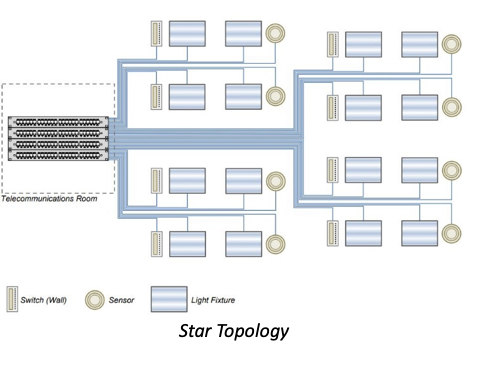
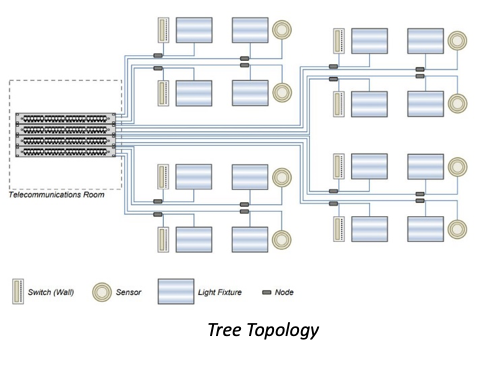
(Courtesy of ANSI/BICSI-007-2020)
Spreading the Light
One of the biggest challenges in the cabling design for PoE LED lighting for both Star and Tree topologies are distance considerations from the TR or node to the actual components. Because these are running on Ethernet cables, the TIA and IEEE standards limit the Category cable runs to 100 meters. But in many instances the cable runs will need to exceed that distance, such as:
- Warehouses that cannot allocate precious square footage for a TR
- Industrial locations that require unique harsh environment cable and connectivity
- Outdoor parking lots or garages in a large environment (ie.: hotels, airports education, campuses and healthcare) which require 24/7 lighting
- Expansive data centers (such as colocation or hyperscale facilities) where square footage costs are at a premium and lighting is an essential utility
- Outbuildings, such as guard shacks, where a TR or enclosure is not a cost-effective or safe options.
The solution to this constant challenge is installing the GameChanger Cable™ from Paige Datacom, which doubles the distance of a typical Category 6 or 6A cable. PoE LED lights use very low bandwidth and power which means that the patented GameChanger cable is UL verified to deliver 10 Mb/s up to 850 feet from the switch in the TR to the device or the node. If using a Star topology, the distance is determined by the voltage drop. (See the GameChanger voltage drop chart). If the lighting components are daisy chained from a node employing a multi-conductor cable the total cable length is determined by the number of devices, wattage required, voltage drop and, of course, gauge (AWG) size (usually, 12, 16 or 18 AWG).
The GameChanger is available in different constructions to suit the specific installation environment including indoor unshielded riser or plenum, outdoor direct burial or shielded OSP. For those industrial locations, GameChanger is also available in an ITC-HL Class 1 Division Armored style specifically designed for hazardous locations. See the complete GameChanger cable specifications here. Many integrators have already seen the light as GameChanger has all scenarios covered and is becoming the recognized superspreader for delivering power and data to smart lighting systems.
